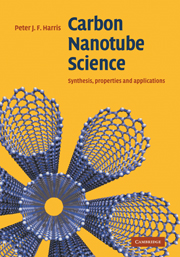Book contents
- Frontmatter
- Contents
- Preface
- 1 Introduction
- 2 Synthesis I: arc- and laser-vaporization, and heat treatment methods
- 3 Synthesis II: catalytic chemical vapour deposition and related methods
- 4 Purification and processing
- 5 Structure
- 6 Physical properties I: electronic
- 7 Physical properties II: mechanical, optical and thermal
- 8 Chemistry and biology of nanotubes
- 9 Carbon nanotube composites
- 10 Filled and heterogeneous nanotubes
- 11 Probes and sensors
- 12 Conclusions
- Name Index
- Subject Index
5 - Structure
Published online by Cambridge University Press: 20 May 2010
- Frontmatter
- Contents
- Preface
- 1 Introduction
- 2 Synthesis I: arc- and laser-vaporization, and heat treatment methods
- 3 Synthesis II: catalytic chemical vapour deposition and related methods
- 4 Purification and processing
- 5 Structure
- 6 Physical properties I: electronic
- 7 Physical properties II: mechanical, optical and thermal
- 8 Chemistry and biology of nanotubes
- 9 Carbon nanotube composites
- 10 Filled and heterogeneous nanotubes
- 11 Probes and sensors
- 12 Conclusions
- Name Index
- Subject Index
Summary
Soon after the discovery of fullerene-related carbon nanotubes it became clear that a completely new framework would be needed to analyse the structures and symmetries of these new materials. Although theoretical methods have been developed for analysing cylindrical arrays in biology (5.1), these are insufficient for a full analysis of nanotube structure. The challenge of formulating the new approaches necessary for classifying nanotube structure was taken up by Mildred Dresselhaus and co-workers, and by Carter White and colleagues, among others. The techniques developed by these groups have been essential in determining the electronic and vibrational properties of nanotubes, as discussed in later chapters. Theoretical discussions have also been given of the layer structure of multiwalled tubes, of tube capping and of other aspects of nanotube structure such as elbow connections.
Experimental studies of nanotube structure have mainly been carried out using microscopy. X-ray and neutron diffraction have generally been of less value, since samples of nanotubes always contain tubes with a wide range of different structures. High-resolution transmission electron microscopy (HRTEM) has been by far the most widely used and most valuable technique. Recent improvements in the resolution of HRTEM have meant that the atomic network which makes up individual tubes can be imaged directly, as well as the layer structure, opening the way for a deeper understanding of their structure. The use of spectroscopic techniques to probe nanotube structure is discussed in Chapter 7.
The present chapter begins with a brief discussion of bonding in graphite and fullerenes. Theoretical models of carbon nanotube structure are then summarized.
- Type
- Chapter
- Information
- Carbon Nanotube ScienceSynthesis, Properties and Applications, pp. 107 - 145Publisher: Cambridge University PressPrint publication year: 2009



